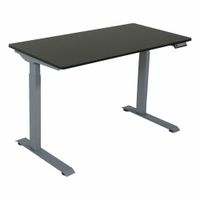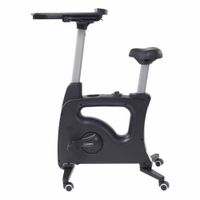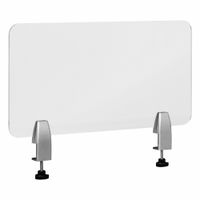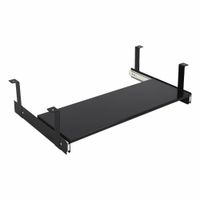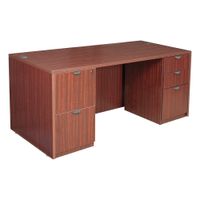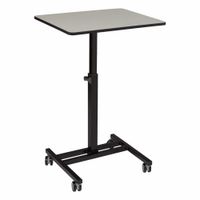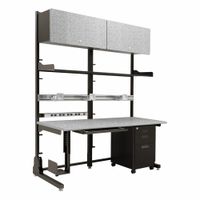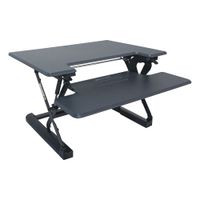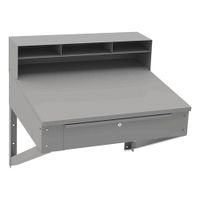Call +(254) 703 030 000 / 751 483 999 / 721 704 777
- Home
- Furnishings Appliances Hospitality
- Furniture
- Office Desks Workstations
Frequently Asked Questions
What is the difference between a fixed-height desk and an adjustable-height desk?
A fixed-height desk is a traditional desk with a set height that cannot be altered. It is designed to accommodate an average user, typically around 28 to 30 inches tall, which may not suit everyone’s ergonomic needs. Users must adjust their chairs or use accessories like footrests to achieve a comfortable working posture. Fixed-height desks are generally more affordable, simpler in design, and require less maintenance due to their lack of moving parts.
In contrast, an adjustable-height desk, often referred to as a sit-stand desk, allows users to modify the desk's height to suit their individual preferences and ergonomic requirements. These desks can be adjusted manually, with a crank, or electronically, with a motorized system. Adjustable-height desks promote better posture by enabling users to switch between sitting and standing positions, which can reduce the risk of musculoskeletal issues and improve circulation. They are ideal for shared workspaces or environments where multiple users with different height requirements use the same desk.
While adjustable-height desks offer greater flexibility and health benefits, they tend to be more expensive and may require more maintenance due to their mechanical components. Additionally, they may have a more complex design, which can impact aesthetics and space utilization.
In summary, the primary difference lies in the ability to adjust the desk's height, with fixed-height desks offering simplicity and cost-effectiveness, and adjustable-height desks providing ergonomic benefits and versatility.
How do standing desk converters work?
Standing desk converters are devices designed to transform a regular desk into a standing desk, allowing users to alternate between sitting and standing positions while working. They typically consist of a platform that can hold a computer monitor, keyboard, and other office essentials. The converter is placed on top of an existing desk and can be adjusted to different heights.
The mechanism of a standing desk converter varies by design but generally involves a lift system that can be manual or electric. Manual converters often use a spring-loaded or gas-lift mechanism, allowing the user to raise or lower the platform by applying a small amount of force. Some models use a series of levers or a scissor-lift design to facilitate smooth height adjustments. Electric converters, on the other hand, use a motorized system to adjust the height at the push of a button, offering more convenience and precision.
Most standing desk converters are designed to be stable and sturdy, ensuring that the equipment placed on them remains secure during height adjustments. They often feature a locking mechanism to keep the platform at the desired height. Some models also include additional features like cable management systems, built-in USB ports, or separate tiers for monitors and keyboards to enhance ergonomics and organization.
Overall, standing desk converters provide a flexible and cost-effective solution for those looking to incorporate standing into their work routine without replacing their existing desk. They promote better posture, reduce the risk of sedentary-related health issues, and can improve productivity by allowing users to switch between sitting and standing throughout the day.
What are the benefits of using cubicle workstations and privacy panels?
Cubicle workstations and privacy panels offer several benefits in office environments. They provide a structured and organized workspace, which can enhance productivity by minimizing distractions and creating a sense of personal space. This setup allows employees to focus better on their tasks, leading to improved efficiency and output.
Privacy panels help reduce noise levels, which is crucial in maintaining a quiet and conducive work environment. By dampening sound, these panels allow employees to concentrate without being disturbed by conversations or office equipment noise, thus reducing stress and increasing job satisfaction.
Cubicles also offer a degree of privacy, which is essential for tasks that require concentration or confidentiality. Employees can work on sensitive projects without the risk of information being inadvertently shared. This privacy fosters a sense of security and trust within the workplace.
Additionally, cubicle workstations can be customized to fit the needs of individual employees. They can be equipped with storage solutions, ergonomic furniture, and personalized decor, which can enhance comfort and personal well-being. This customization can lead to increased employee morale and a sense of ownership over their workspace.
From a management perspective, cubicles are cost-effective and flexible. They allow for efficient use of office space and can be easily reconfigured to accommodate changes in team size or office layout. This adaptability is beneficial for growing companies or those undergoing restructuring.
Overall, cubicle workstations and privacy panels contribute to a balanced work environment by combining the benefits of open-plan offices with the need for individual space and privacy. This balance can lead to higher productivity, better employee satisfaction, and a more harmonious workplace.
How do I choose the right office desk for my workspace?
To choose the right office desk for your workspace, consider the following factors:
1. **Space and Size**: Measure your workspace to determine the maximum desk size that fits comfortably. Ensure there's enough room for movement and additional furniture.
2. **Functionality and Purpose**: Identify the primary use of the desk. If you need it for computer work, ensure it has cable management features. For paperwork, a larger surface area is beneficial.
3. **Ergonomics**: Choose a desk that supports good posture. The height should allow your feet to rest flat on the floor, and your arms should be at a 90-degree angle when typing.
4. **Storage Needs**: Consider desks with built-in storage like drawers or shelves if you need to store documents and office supplies.
5. **Material and Durability**: Select a desk made from durable materials like solid wood, metal, or high-quality laminate, depending on your budget and style preference.
6. **Style and Aesthetics**: Match the desk style with your office decor. Options range from modern and minimalist to traditional and ornate.
7. **Budget**: Set a budget and explore options within that range. Remember that investing in a quality desk can enhance productivity and comfort.
8. **Flexibility and Adjustability**: Consider adjustable desks if you prefer to alternate between sitting and standing. This can improve health and productivity.
9. **Assembly and Maintenance**: Check if the desk requires assembly and if it’s easy to maintain. Some materials may require more upkeep than others.
10. **Reviews and Recommendations**: Read reviews and seek recommendations to ensure the desk meets your expectations in terms of quality and functionality.
By evaluating these factors, you can select a desk that enhances your workspace's efficiency and comfort.
What are the advantages of using laptop and mobile computer carts?
Laptop and mobile computer carts offer several advantages, particularly in environments like schools, hospitals, and offices:
1. **Mobility**: These carts allow for easy transportation of laptops and other devices between rooms or locations, facilitating flexible workspaces and learning environments.
2. **Space Efficiency**: They help in organizing and storing multiple devices in a compact manner, saving space and reducing clutter in classrooms or offices.
3. **Charging Capabilities**: Many carts come equipped with built-in charging stations, ensuring that devices are always ready for use without the need for multiple power outlets.
4. **Security**: Carts often include locking mechanisms to secure devices, protecting them from theft or unauthorized access.
5. **Improved Collaboration**: By enabling easy movement of technology, these carts support collaborative work and learning, allowing groups to gather around shared screens or devices.
6. **Cost-Effectiveness**: Instead of purchasing multiple stationary setups, a single cart can serve multiple users or classrooms, optimizing resource allocation.
7. **Enhanced Organization**: Carts typically have designated slots or compartments for each device, helping to keep equipment organized and reducing the risk of damage.
8. **Versatility**: They can accommodate various types of devices, including laptops, tablets, and other peripherals, making them adaptable to different technological needs.
9. **Ease of Maintenance**: Centralized storage and charging simplify the process of updating software or performing maintenance on multiple devices simultaneously.
10. **Increased Accessibility**: By bringing technology directly to users, carts ensure that devices are accessible to all, including those with mobility challenges.
Overall, laptop and mobile computer carts enhance the efficiency, security, and accessibility of technology in various settings, supporting dynamic and adaptable work and learning environments.
How can I improve the ergonomics of my workstation?
To enhance the ergonomics of your workstation, start by adjusting your chair. Ensure it supports your lower back, with your feet flat on the floor or on a footrest, and knees at a 90-degree angle. The chair should allow for slight recline to reduce spine pressure.
Position your monitor at eye level, about an arm's length away, to prevent neck strain. The top of the screen should be at or slightly below eye level. Use a monitor stand if necessary.
Arrange your keyboard and mouse so your wrists are straight and your arms are close to your body, forming an L-shape at the elbow. Consider using a keyboard tray or wrist rest to maintain a neutral wrist position.
Ensure adequate lighting to reduce eye strain. Use task lighting to illuminate your work area without causing glare on your screen. Adjust screen brightness and contrast to comfortable levels.
Incorporate regular breaks to reduce fatigue. Follow the 20-20-20 rule: every 20 minutes, look at something 20 feet away for 20 seconds. Stand, stretch, or walk around periodically to improve circulation.
Organize your desk to keep frequently used items within easy reach, minimizing excessive stretching or twisting. Use document holders to keep papers at eye level.
Consider ergonomic accessories like a standing desk converter, ergonomic chair, or anti-fatigue mat if standing. These can promote better posture and reduce strain.
Finally, maintain a clean and clutter-free workspace to enhance focus and efficiency. Regularly reassess your setup and make adjustments as needed to ensure ongoing comfort and productivity.
What accessories are available to enhance the functionality of my office desk?
To enhance the functionality of your office desk, consider the following accessories:
1. **Monitor Stand/Riser**: Elevates your monitor to eye level, reducing neck strain and freeing up desk space.
2. **Desk Organizer**: Keeps pens, notepads, and other small items neatly arranged, reducing clutter.
3. **Cable Management Solutions**: Includes cable clips, sleeves, and trays to keep cords organized and out of sight.
4. **Keyboard Tray**: Provides an ergonomic typing position and frees up desk space.
5. **Mouse Pad with Wrist Rest**: Offers comfort and support for your wrist during extended computer use.
6. **Desk Lamp**: Provides adequate lighting, reducing eye strain and improving focus.
7. **Adjustable Laptop Stand**: Raises your laptop to a comfortable viewing height, promoting better posture.
8. **File Organizer**: Keeps important documents and files within easy reach and organized.
9. **Whiteboard or Corkboard**: Useful for jotting down notes, reminders, or pinning important documents.
10. **Under-Desk Drawer**: Adds storage space for personal items or office supplies without taking up desktop space.
11. **Footrest**: Enhances comfort by supporting your feet and promoting better posture.
12. **Headphone Stand**: Keeps headphones accessible and prevents tangling.
13. **Desk Mat**: Protects the desk surface and provides a smooth writing or mouse surface.
14. **USB Hub**: Expands the number of available USB ports for connecting multiple devices.
15. **Phone Stand/Holder**: Keeps your phone visible and accessible for calls or notifications.
16. **Plants or Greenery**: Adds a touch of nature, improving mood and air quality.
17. **Ergonomic Chair**: Complements your desk setup by providing proper support and comfort.
These accessories can significantly improve the efficiency, organization, and comfort of your workspace.
